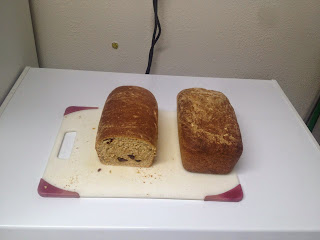 |
| Hanging in a local kitchen. |
The recipe for Bacon Apple Moose Meatloaf included a brief description of acquiring the required moose burger. Everyone I know in Galena use Moose as widely as other American's use beef (I don't think we've eaten beef since August). Moose hunting is therefore a serious endeavor each fall for many people. I was kindly invited to go along with a new friend Jason and his son Daniel one weekend last September in the midst of firewood cutting. I'd never been moose hunting (or really any kind of big game hunting) despite growing up in Alaska and was thankful to have an experienced local invite me along.
Hunting is a bit like hiking, but instead of trying to be loud to scare away animals you're supposed to walk quietly so they don't hear you. It was a bit of a hard switch trying to make zero noise while walking in the woods.
 |
| Saturday brought a beautiful morning to spend on the edge of a lake. |
 |
| After a couple hours a cow moose came across the lake to me. Cows are not legal in this area so I just watched quietly and took a picture. |
 |
| I spent a long time scanning the grass with as little movement as possible. |
 |
| Another sunset on the lake. No moose, but it was a great day anyway. |
 |
| Back at camp watching the fire and waiting for Jason and Daniel to return from their hunt. |
 |
| I still amazes me how still the river can be at times. |
 |
| Sunday morning we all went to the spot I had spent Saturday. |
 |
| Unfortunately the moose had just enough life to run into the lake. We pulled it out using the winch on Jason's 4-wheeler. |
 |
| Daniel pulling the antlers to the side so they don't snag in the mud and Jason winches the moose onto the bank. |
 |
| Heading back up the river with a boat full of moose. We made it home just before sunset |
I've often heard people say how great it was to get "free" meat (mostly moose, caribou, sheep, or bear) and fish (salmon and sometimes halibut) in Alaska. My dad taught me long ago that this food isn't really free and although we did fish, we raised animals instead of hunting when I was younger. I think people forget that it takes hard work and often expensive equipment to go into the woods and bring back food. Then we mistake it as free because we didn't directly spend much money on it like we would buying meat at the store. Thinking about that while I worked at cutting up moose meat left me wondering* what my moose burger is actually worth. The following musings are not an attempt to establish an accurate fair market price, merely to have a ROM estimate to satisfy my own curiosity.
Costs:
Equipment - A lot of money can be spent on a boat, 4-wheelers, rifles and hunting camp. I don't have anyway of estimating the depreciation associated with hunting so I'm going ignore this even though it is significant.
Supplies (fuel, food and hunting license for the group) - I think this came out to about 300 dollars (mostly fuel) for the weekend or one dollar per pound of meat.
Time - I don't think the time spent hunting should be included. I enjoy being in the woods and have spent many days walking though the wilderness without getting any food. That leaves the time to field dress the moose haul it home and process it. I think the combined work of everyone involve probably exceeded 60 hours. That works out to about 5 pounds of meat per hour.
Before going hunting I was looking up prices for beef and found an assortment of beef cuts for about $5/lb plus $1/lb for shipping. If we equate moose to beef and trade supply costs for shipping that works out to about $25/hr (tax free). On one hand, even though I'm ignoring the cost of equipment and the time spent actually hunting the moose, all of the adults involved are capable of earning more at a "real job". On the other hand, although it's hard work moose processing, like firewood cutting, isn't quite the same as "working" in the corporate sense. There is also something about eating something you grow or hunt yourself that makes the work more enjoyable and moose is delicious.
Where does that put the time value of moose? There's a reason our ancestors traded hunting for farming and industry. If we're evaluating this from a purely economic sense, hunting might make sense for anyone who is unemployed or earning low wages and also already has the required equipment. If I'm a working tradesman or professional trying to justify taking a week off for moose hunting I should probably admit that I really just like going hunting** and the "free" meat is only a nice bonus.
*Seriously, I just naturally wonder about these things while I work. That's why engineering economics was probably the most influential course I took in college. Learning how to calculate and understand opportunity cost, realizing that the value of everything changes with respect to time, and discovering that the time value of money could be calculated is what pushed me from being a natural saver to becoming an investor.
**I also did the math for Salmon fishing and the result is the same. It's more profitable to stay at work, but it's a lot more enjoyable sitting on the bank of the Copper River and Sockeye Salmon is also delicious.


















































